#why is ratio using a computer from 1995? well
Explore tagged Tumblr posts
Text

🖥️💾
#aventurine#hsr aventurine#dr ratio#veritas ratio#ratiorine#aventio#raturine#ratio hsr#i respect that ratiorine/aventio are the fandom picks for ship name but raturine is objectively the funniest. sorry#why is ratio using a computer from 1995? well#hsr#honkai star rail#honkai
6K notes
·
View notes
Text
Here's a pet peeve of mine:
When DVD first came out, a lot of publishers either didn't understand or didn't care to understand the format, and this affect how they choose to format some widescreen movies. See, architecturally DVD only really supports two aspect ratios: 4 to 3 and 16 to 9. In either case, the resolution will be the same (720x480 @ 30fps or 720x576 @ 25fps), but in widescreen these pixels are horizontally stretched.
Now, many widescreen films are not a 16 to 9 aspect ratio, necessitating black bars ("letterboxing") below and atop the actual video, like this:

The Black Hole (1979), 2004 DVD release
This wastes bandwith, of course. In that Black Hole example, a whole 23% of the video data on that disc is being wasted on black bars. The effective resolution is only 720x368! But it's the better than the alternative: encoding widescreen video as letterboxed 4 to 3. Here's the widescreen version of A Fistful of Dollars' 1999 release:

A Fistful of Dollars (1964), 1999 DVD release
53% of that video is black bars. That's more than half! We're left with an effective resolution of only 720x196, and on my monitor (16 to 10 aspect ratio), the movie is left looking pretty stupid:

It's not awful, and VLC can alleviate the windowboxing by cropping, but you still have to suffer the compromised vertical resolution.
Fortunately for us film enjoyers with eyes, this basically stopped being a problem around the mid 2000s. Widescreen televisions had finally started selling in real numbers, so studios started having to care. This particular formatting problem only only really affects you if you buy all your movies from thrift stores, like I do.
Unfortunately, Blu-ray sort of re-introduced this problem in the other direction. HD and UHD Blu-rays can only store video in 16 to 9 widescreen. This is basically fine for most people, given that 16 to 9 displays are really the only kind anyone makes anymore (well, for TVs and computers anyway). I am not most people. Here's Evangelion on my monitor:

Neon Genesis Evangelion (1995), 2021 Blu-ray The Complete Series release
Ooh, so close. VLC will let us crop to 4:3 to remove the letterboxing, but for whatever reason this fucks up the captioning layer.

No clue why, can't figure out how to fix it. This affects DVD subtitles too, but fortunately most of my DVDs with aspect ratio problems are English-language and thus don't need subtitles. Not so here. This seems to be a long-standing bug in VLC, and it looks unlikely anyone is working on fixing it.
Aspect ratios suck.
2 notes
·
View notes
Text
Was "The Best of Dr. Seuss" Really His Best Works?
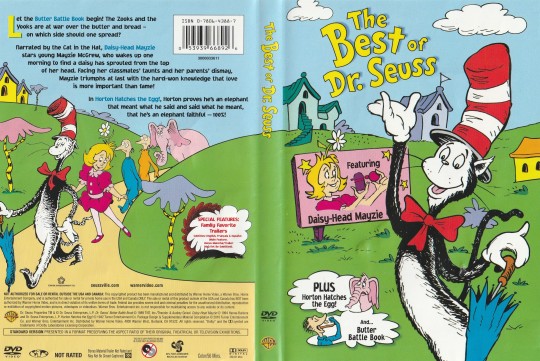
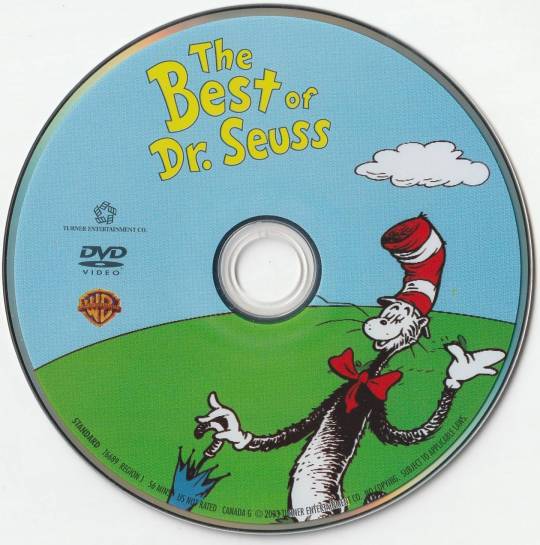
Butter battles, daisies growing on heads and elephants hatching eggs galore, 2000's "The Best of Dr. Seuss" compilation program has the formulaic balance of entertainment that I'm sure that a child would love, right? Of course, we can see Dr. Seuss' beloved character The Cat in the Hat all over the packaging and your kid must think "Hey, it's that cat from the book I just read!". And you'd be correct. This is the 2003 DVD version I'll be covering here on this blog.
The first thing you'll notice right away when you pop in the disc is the menu design which pulls off some creative work the home video team at Warner Bros. had ever put out.
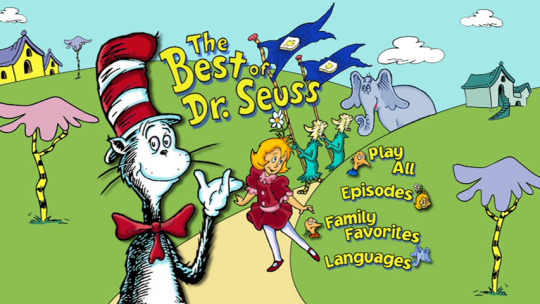
As you can see, the menus themselves are drawn in Dr. Seuss' trademark art style with some detailed backgrounds. The Cat on both these and the packaging looked like he was traced from the book he originated from. However, you are not going to be ready for what he looks like in one of these stories.
Although all of these menus are presented in 16:9 widescreen if you play them on a computer like I do, the contents are actually in 4:3 aspect ratio. So, let's go through all three stories one at a time and see if they're a good fit on this DVD.
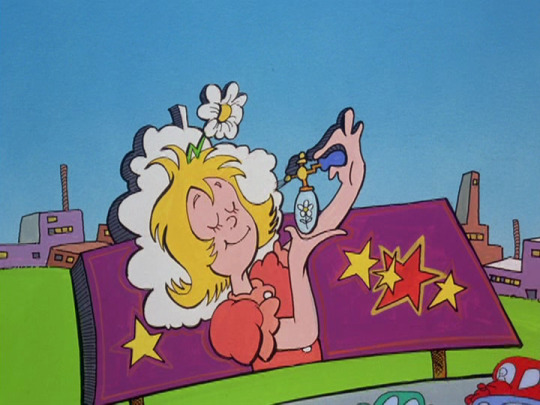
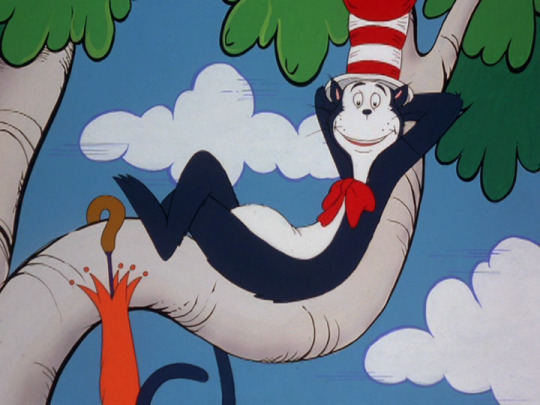
First, we have "Daisy-Head Mayzie", a TV special completed in 1994 -- given the copyright disclaimer, but never aired on TV until February 5, 1995. This would be one of Seuss' final works before he passed away. The special was previously released individually on VHS a few months after its original broadcast, and was also the final voice credit for Henry Gibson; already recognizable as the voice of Wilbur the pig from Hanna-Barbera's "Charlotte's Web" adaptation. A real coincidence, given that both Gibson and H-B worked on this, too.
Fran Smith, the voice of Helga in Nickelodeon's "Hey Arnold!" would make her voice acting debut in this special as the titular Mayzie McGrew. Now this is a year before that show would even premiere on TV, so I'm not surprised.
Yeah, this would be forgettable without the addition of The Cat in the Hat, which in this special looked A LOT more off-model than he does in the DePatie-Freleng specials. It almost makes it feel like a bootleg version of Seuss' popular character compared to what the packaging and menus gave us. Oh well, at least they tried.
One reason I like to know why they made him that way in the first place was this is a co-production between two unlikely companies that never even made any Dr. Seuss adaptations beforehand.
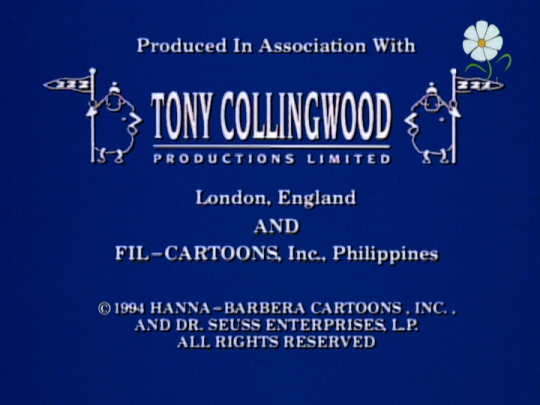
As you may have just read from the credits, a British animation studio named Tony Collingwood Productions (now known as "Collingwood & Co.") was largely responsible for the production of this special.
So, you may get some Britishness in the way it was produced. Hanna-Barbera Cartoons, an otherwise American studio that got rebranded in 2001 as "Cartoon Network Studios",
I've never actually seen Hanna-Barbera work on a Dr. Seuss special before (rival studio DePatie-Freleng did most of their Seuss specials prior to this), so it is kinda interesting to see a British-American joint venture.
The special itself was.... eh, it was okay. I kinda prefer Seuss' original illustrations made before they were changed (the daisy being the only character to teach Mayzie a valuable lesson instead of The Cat), but I think this would be something interesting if you're a parent looking for entertainment for your youngest child.
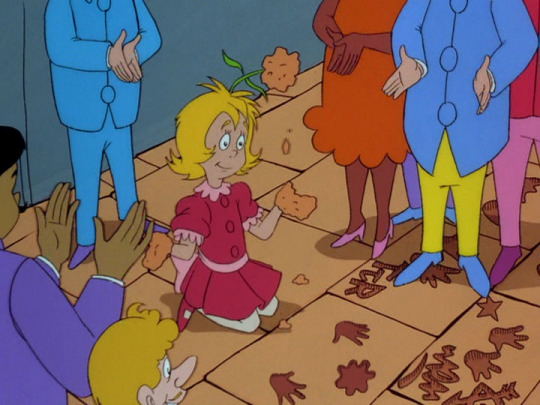
As for the quality? For a previously-separate TV special, it sure looked better on DVD than it ever does, due to it being remastered from the original material (at least for 2003 standards). While not Seuss' greatest work overall, it's so nice to see this being presented in clear pristine quality.
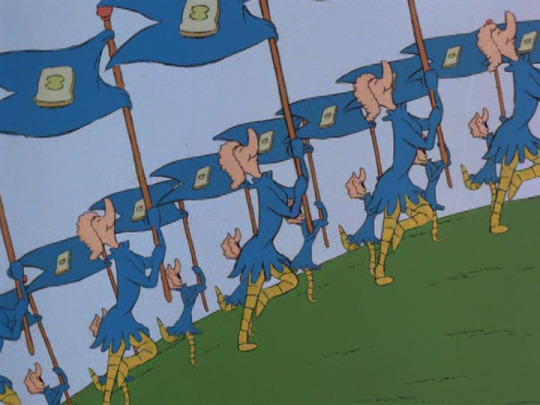

Another previously-separate TV special is adult film director Ralph Bakshi's version of "The Butter Battle Book", and is surprisingly better than I thought. It's accurate to the original source material and has rarely even been talked about due to its themes of war.
The original book had even gotten as far as having been banned in some Canadian libraries due to its close ties with the Cold War, which was still ongoing at the time of its publication.

Now prove me wrong, I have never actually seen any of Bakshi's works, but this is something. I love how Bakshi and his team are able to keep the ending from the book, which ends the story on a cliffhanger. This was also released on VHS, but unlike "Daisy-Head Mayzie", there's actually TWO different releases of the same special released a few years from each other.
Although a much better special than "Daisy-Head Mayzie", the picture quality has the same level of squeaky clean quality as that special, so I'll forgo the explanation.

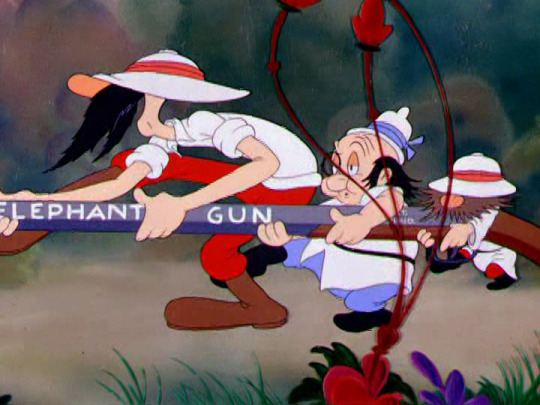
And to wrap up the compilation came not a TV special, but a cartoon short film created by Warner Bros. themselves! You heard me right. The boys at Termite Terrace made a 9-minute adaptation of Dr. Seuss' earlier book "Horton Hatches the Egg".
Directed by Bob Clampett, this is an unexpected surprise to anyone who grew up with any of Dr. Seuss' works (like me). What makes this especially perfect is the vocal performances of Kent Rogers, Sara Berner and Mel Blanc. Now, why did they make Horton's skin pink? Either it's a creative choice made by Clampett's unit or they felt that grey was too common for an elephant's color.
There IS a distinction between this and the other two Dr. Seuss stories I've covered so far and that as this is a Looney Tunes cartoon, it has actually had some home video releases in the 90s by both MGM/UA and Warner Bros.
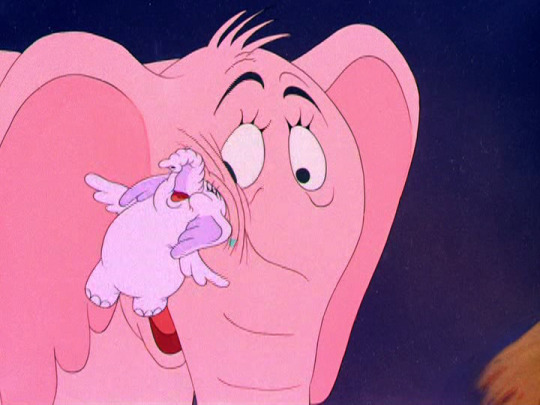
Also, the picture quality on this cartoon has the same level of excellence as the Golden Collection. So much so that it got re-released on DVD as part of the sixth volume of the Looney Tunes: Golden Collection series (which I'll get to when I'll do an entire blog on this series by itself).
Time to move onto the bonus features this DVD has.



So... all there is as extras are three trailers (or "Family Favorites" as the menus call them). Each of these trailers are for a collection of Tom & Jerry DVDs, the annoying little brat Caillou's Christmas-themed movie and a German animated film called "The Little Polar Bear" ("Der Kleine Eisbär").
You do have language options for the program itself, though they're for subtitles only. A real disappointment for those of you who are expecting dubs. I will admit, watching these in a subtitled language can be pretty fun, no matter if you're Hispanic or French-Canadian.

Overall, if you are able to watch these three Dr. Seuss cartoons, I highly recommend picking up the 2008 Deluxe Edition "Horton Hears a Who" DVD. And in case you haven't read the copyright disclaimer on the cover, my copy is a 2010 reprint.
And by reprint, I mean the Warner Bros. home video department updated the packaging, but nothing else. This is something I'll see a lot more of when I look at a few other Warner DVD releases on this blog. So, keep an eye out!
By the way, both "Daisy-Head Mayzie" and "The Butter Battle Book" are free to watch on YouTube despite being under copyright. "Horton Hatches the Egg", however, is another story and is usually blocked worldwide on YouTube (I learned the hard way on how copyright works on there, so good luck watching it on Dailymotion if you can!)
6 notes
·
View notes
Text
To Infinity and Beyond: how animation evolved through time
Before Infinity and Beyond
by Isabelle C. Barona and John Stephen J. Wilwayco
As animators discover computers, animations are expected to change over time. Toy Story is known to be the first-ever major animation in motion pictures’ history. As it clearly seems to be, noticeable differences between the two creations of Toy Story isn’t hard to distinguish as it can be seen through the animations’ quality of the movie itself, the sound effects, the voice actors, and even the unnoticeable little information like dust particles, scratches, and the likes that can be seen throughout the entirety of the movie.
Toy Story’s director, John Lasseter, envisioned a new experience that would not only satisfy the child in his soul, but would also take the audience into a fresh journey that will astound them.
Lasseter’s imagination led him and his team to make an astonishing creation that would soon make a new name for film. He even highlighted the passion of his team for Toy Story’s creation, saying “every animator is a child at heart.” And so, he wanted to extend that passion and love for toys into the big screens.
At the very beginning, Toy Story has already made a big statement. Their release was huge and the fan base, colossal. In a behind-the-scenes video, the creators have shown how large their efforts were in creating the film in the 90’s (VHSfx, 2013). It turned out well, with nicely rendered animations that at one point in that period, seemed incredible.
Time, however, is a big factor for evolution. One could even tell that Toy Story 4 today is quite incomparable to where it first started. In a documentary by Insider (2019), Toy Story 4 was featured and people went crazy from how detailed the movie was made into. It seemed like an animation imitating reality.
According to Ashton (2019), for more than two decades, Pixar did successfully establish itself by committing undeniable excellence when it comes to making animations. A lot of changes did really happen for Pixar from November 22, 1995 up until June 21, 2019. With Pixar’s unique advancement in terms of computer animation, it continues to pride itself as a studio which produces invigorating ideas to the forefront. This is why Toy Story 1995 and Toy Story 4 are really the ones that paved the way for Pixar to continue growing significantly as a top-tier animation house in the industry.
Getting Technical
by Andrei Arcellana and Jerome Anthony Mangalus
The Toy Story cartoon animation movie has been part of everyone’s childhood since this is the first animated cartoon in the cinema in 1995. And in 2019, the new latest film of Pixar, which is Toy Story 4, has been released, and it became a trending topic because of its 24 years gap and the focus of the animators on the little details of the said film. According to Desiderio & Phillips (2020), before achieving this almost to reality quality of the film, Pixar first used and experimented with these elements on the films prior to Toy Story 4 like Monster’s Inc, Bugs Life, Finding Nemo, Ratatouille, The Incredibles, Cars, etc. The details of the humans on the first Toy Story were not perfect, using all the elements that are in the films mentioned in the previous sentences, they have fully created the Toy Story 4 with almost to reality graphics. Additionally, the technology that was used in creating both movies was very different.
As claimed by Desiderio and Phillips (2020), getting to the present sequel of Toy Story required numerous innovations. Rendering was the biggest factor in creating both movies. In the creation of the 1st Toy Story, 117 computers that were in operation 24/7 were used. To properly handle the rendering of the 1st Toy Story, they have created an application that is called Renderman. Using all these computers and applications, the movie was in 4 years of making. The producers said that if they render the first film in today’s time, it would be faster than watching the said movie. But to create good quality graphics, rendering one frame in creating Toy Story 4 had occurred for 60 to 160 hours. Overall, 5 years was used to make and fully create the Toy Story 4.
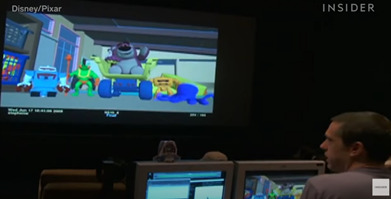
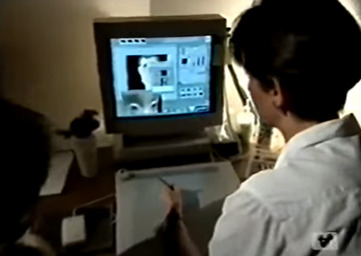
Furthermore, the technology behind the animation of the “Toy Story” had a main factor to consider in order to make it happen, which is the rendering. Rendering is where the computer saves each video frame with lighting and motion effects, and these video frames are the ones that make up the movie. The animators of the “Toy Story” had to run 117 computers that are running 24 hours a day. These computers had to render each frame that could be 45 minutes to 1800 minutes (30 hours) and it also depends on the complexity of the frame, and they have to render a total of 114,240 frames.
For the movie “Toy Story 4” the animation process also includes rendering, but because of the advancement of the technology, computers that rendered the movie are high-powered computers that are able to put elements like CG scenes, geometry, lighting, and motion effects. Sisson said, “the most expensive frame from the movie “Toy Story 4” took about 325 hours to render, and it is running on a computer with four cores” (May, 2021).
Little Details Require a Big Cost
by Jesse Jerome Jamias and Shanelle C. de Luna
We noticed a lot more details especially on their differences since it's quite noticeable in a good way because it improved. First on the list is Toy Story’s Scud vs Toy Story 4’s cat, it is a big achievement during the late 90’s to animate a dog but the detail in the fur isn’t there compared to Toy Story 4’s cat wherein it looks realistic and is made with noticeable attention to detail. Next is that during the first Toy Story, there were a lot of limitations, for instance Pixar in the early years hadn’t quite figured out how to fully animate human characters and there were a lot of shots of hands and feet so the viewer wouldn’t see any missing details. Lastly, we also noticed how the screen got bigger. Toy Story 1 used a 1.85:1 aspect ratio while Toy Story 4 expanded to 2.39:1. After all, 24 years is a lot considering the fact that technology is constantly evolving.




The evolution of animation back when the first movie of “Toy Story” came out up until the most recent film in the franchise “Toy Story 4” came out. We can definitely see the evolution and improvements in these movies. The changes between these two movies are quite considerable knowing that these 2 movies are more than 20 years apart and perfectly shows the evolution of animation over the years.
Back when the first Toy Story movie came out it was the first computer-animated film to ever be released with the budget of the movie being around $30,000,000 it paved the way for the continual advancement of computer-animated films. Fast forward to 2019 for the release of Toy Story 4 we can see how far this industry has come and the noticeable changes in the animation itself, now having a budget of around $200,000,000 we can see just how amazing the technological advancements and evolution of animation has come just from this movie franchise.
Toy Story’s Timeless Effect
by Bhrylle Humbert Corpuz
Starting from when we were kids we all loved a lot of animation films and cartoons. The entertainment, the fun, the joy it brings us really puts our minds at ease, forgetting about the worries and acting just like kids. But, one of the most eye-catchers or the reason we are so immersed from these kinds of films we are watching is its animation and its beautiful colors.
Thinking about it, if we are to compare the animated films we watched back when we were kids to today’s new animated films we can see a lot of difference. For example, if we are to compare Toy story 1 to Toy story 4, we will notice a lot of new things from the two movies. The most noticeable factor is its graphics design, the lightings and the animation for each scene in both movies. As we all know that these things are the most eye-catching factors when watching a movie especially if their target viewers are children.
Over time, we can see Pixar’s improvement and innovation as they continue to make great and wholesome animation films. Considering the 24 years gap between the two movies we can see the progress and success of both films. Ever since the creation of the first toy story movie they made good use of the technology, the tools, the equipment around them and with the ability of using their great minds to make an outstanding masterpiece.
As they continually do this their skills continue to improve to bring us new high quality films. This also shows how much animation evolved through years. With continuous practice and with the continuous innovation in technology we are able to improve and produce better high quality animation films.
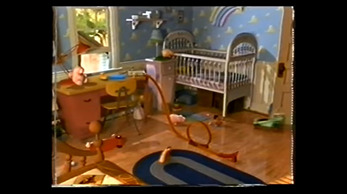
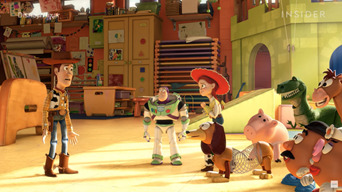
Photos taken from the documentaries: “The Making of Toy Story - (1995)” and “How Pixar’s ‘Toy Story 4’ Was Animated | Movies Insider”, it depicts the difference of the graphics design, lightings, shadings etc., from the movies Toy Story and Toy Story 4.
References
Ashton, W. (2019). Toy Story Vs. Toy Story 4: How Pixar's Animation Has Changed Over The Last 24 Years. CinemaBlend. https://www.cinemablend.com/news/2475686/toy-story-vs-toy-story-4-how-pixars-animation-has-changed-over-the-last-24-years.
Copper, L. (2019, September 16). The Evolution of Toy Story’s Animation. GCU. https://www.gcu.edu/blog/performing-arts-digital-arts/evolution-toy-storys-animation
Desiderio K. & Phillips I. (2020) How Pixar's animation has evolved over 24 years, from 'Toy Story' to 'Toy Story 4'. Insider. https://www.insider.com/pixars-animation-evolved-toy-story-2019-6
Insider. (2019, July 9). How Pixar’s ‘Toy’s Story 4’ was animated | movies insider. [Video]. YouTube. https://www.youtube.com/watch?v=fT_LdcWFHkA
VHSfx. (2013, February 12). The making of Toy Story - 1995 [Video]. YouTube. https://www.youtube.com/watch?v=1VdERcRJ3jI
May, T. (2021, January 26). 8 mind-boggling facts about the making of Toy Story 4. https://www.creativebloq.com/news/mind-boggling.toy-story-4-facts.
1 note
·
View note
Text
Trying to deconstruct QuackerJack's vocabulary to a more easy to replicate format so I can understand the proper pool of words and phrases to pull from that fit his mannerisms, and it's just
"Rat Fink" (spoken in "Quack of Ages", after being outted for his deceit) seems to originate in 1964, which is great because that falls in line with my headcanon/assumption that QuackerJack was likely born in the 1950s, so 1964 would be in his early teen years, and that phrase is basically like calling someone out as a snitch or tattler, so it fits his general vocab as well as shows that his being emotionally stuck in the prime of his days is pretty well rooted.
Then we get words like "Fop" (spoken in "Whiffle While You Work", in which he hypocritically calls Darkwing as such, when he himself is far more fitting of the description).
How old is "Fop"?
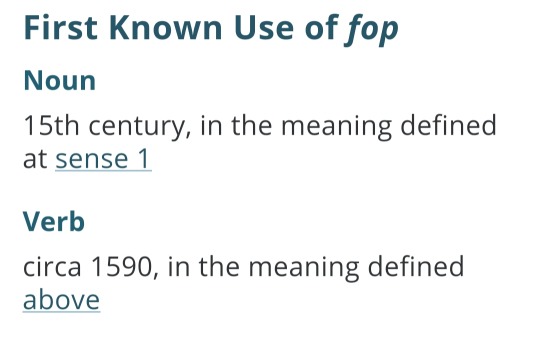
... Of course. In fact, I do recall that the time travel portion of "Quack of Ages" takes place in 1592, so it's rather amusing that QuackerJack is 100% committed to this jester persona down to the word pool. Impressive, really.
Almost as if he may have use the Time Top more times than we've actually seen, in order to really get in the role, because why go to the Renaissance Faire when you can just get the real deal experience a la Bill and Ted style absurdity? I mean, he has to have at least tested it a few times before he knew that it most certainly would have worked as he expected in "Quack of Ages".
So now we have a wide pool of words already. QuackerJack can (and will most likely) speak like a court jester. He also will likely use slang that was popular in his youth, so you can also pull from 1950s-1980s, since he doesn't seem to really use too much 1990s terminology as well.
Why might I specifically say 1980s? Well, the cartoon takes place in 1991-1992, and 1980s wasn't too far behind it, and also

"Code Monkeys"
It's hard to pin down the origin years of the term, but it's seems to have made itself prevalent in the 1980s, and as it's a bit of a rude term meant to insult computer programmers by implying thier job could be easily done by a monkey smacking away at a keyboard for similar results (and gosh golly gee, ain't that the sort of phrase QuackerJack would have absolutely absorbed into his vocabulary, like the total luddite that he is)
So it seems that you can draw from quite a bit to pull some in-character idioms and age appropriate and themed phases.
Then I realized that it would make sense that the lexicon of all variations of the talking Mr. Banana Brains would have to be something of an extension of QuackerJack's preexisting vocabulary, as Mr. Banana Brain is merely an extension of QuackerJack.
Simply put: Mr. Banana Brain realistically cannot know phrases and terminology that QuackerJack is unaware of. QuackerJack subconsciously brings the voice to Mr. Banana Brain, therefore Mr. Banana Brain's vocabulary pool is QuackerJack's as well, and Mr. Banana Brain cannot know something that QuackerJack does not.
At least, logically so.
Granted, the series has never been 100% rigid with thier rules of physics and world building, as Mr. Banana Brain himself is such an oddity that may or may not be sentient himself, if only for the sake of plot convience or "rule of funny".
That brings me to this interesting bit from "The New and Improved Mr. Banana Brain" from the "Toy With Me" story


On the left is the original retail bit, and on the right is the Definitively Dangerous Edition change.
Bare in mind, this is under my assumption that the Mr. Banana Brains' vocabulary pool is identical to QuackerJack's to the T, no margin for variables.
Now, "new blood" is a relatively old phrase

Ah, the 1800s. Fits well between "Fop" and "Rat Fink"
Very plausible as a statement QuackerJack could use in terms of running a business, or might I say a Toy Empire?
But this change they made in the Definitively Dangerous Edition... is interesting.
"Old and busted" and "New hotness".
It's a very, very familiar pair of terms to me, and really stands out for a choice of speech here, and it's bizzare to think it's in QuackerJack's vocabulary, because, let me break it down for you
Where have we likely heard the combination of "Old and busted" and "New hotness" before?
youtube
"Men in Black II"
Which was released in 2002.
And the original film was released in 1997.
The original Darkwing Duck took place in 1991-1992, and while the comic continuation was released in 2011 (and shows modern technology and Disney cameos that existed after 1992)... The comics pretty much state that it takes place more or less a year or so after the cartoon, placing it in some futuristic aesthetic 1993-ish, maybe 1994.
Actually, I really want to say like 1995 or 1996, that's a good number stretches out QuackerJack spiraling bad luck into a less crunched timeline and gives him more time with Claire, but I digress
Anyway, I haven't actually heard the combination of "Old and busted" and "New hotness" used in anything OTHER than MIB2 and people who are referring to this scene.
Therefore, given that it's oddly out of place, I have to conclude that QuackerJack has done more unauthorized Time Crimes than we initially thought, and he most certainly popped over to 2002 to watch "Men in Black II" in theaters because why the heck not, who's going to stop him, amirite??
Or maybe the comic timeline exists parallel to ours in some wacky time passage ratio, and the Men in Black franchise in the Duck-verse happened sooner than it's dates here by years ahead.
So, in conclusion:
QuackerJack has seen "Men in Black II" and apparently got enough amusement out of the "Old busted hotness" scene that he subconsciously thinks about that periodically, and it finally surfaced via a renegade figment of his own creation gone off the rails
Also:
I'm like 100% sure QuackerJack would have been wheezing at that "WHAT IS A GAMEBOY??" bit.
youtube
... This started as a serious post about breaking down QuackerJack's vocabulary and now it's devolved into speculation that QuackerJack likes scifi action movies.
... Word.
79 notes
·
View notes
Text
Final report of KWHS investment competition
From October to December, I have been participating in an online competition held by Warton Business School- KWHS Online Investment Competition. Being the leader of the team, I (and my teammates) developed a thorough investment strategy and asset portfolio in order to maximize the return in the long run. We achieved a satisfying return and ranking in the end. Our final score was ranked 4th in Region 1. Below is the 25-page final report that I completed for this competition.
Final Report of KWHS
Section1: Team investment strategy:
Cautious trading with “right” timing to buy in
Our team believes that there will be a lot of ups and downs in the world-wide stock market throughout Q4 of the year. For the whole US stock market, it did undergo a lot of variations due to the trade war between the US and China, as well as political factors such as the mid-term election. The continuous rise in interest rates has also driven down the whole US market. We will choose companies cautiously with the right timing to buy in and then hold them firmly for the long term.
Asset allocation + Risk diversification
We as a team strive to find some relatively stable individual stocks that could offer the highest rate of return as possible. We invest in 5 different sectors to diversify our risks in case any sector is not doing well. Under the risk factor, we, therefore, try our best to diversify our portfolio allocation by investing in different sectors, therefore gaining the possible best return.
Investment on the leading companies in each sector for long-term return
Our investment strategy is focused on the leading enterprise or BIG names in each sector to gain a stable return in the long term.
Buying large-dividends companies for short-term cash generation
In the meantime, we also look into several companies that offer GOOD dividends at the end of the year, to generate the short term cash for our client Sachin Rekhi, who has the plan to make a donation to ASPCA annually. Those are normally “blue chip companies” with impressive dividends at the end of the financial year.
In summary, our main focus is to build a portfolio with long-term wealth creation while generating short-term liquidity.
The leading ompanies that we choose may undergo fluctuation, but our team look at them from a long-term perspective and therefore would not buy low and sell high. Under our assumptions, when there are slumps in the whole industry or market, these companies would suffer the least.
We hold a weekly meeting to monitor and discuss the performance in each sector, after which we modify and improve our tactic under each sector. In addition, we are also left about 5% of the total asset, which is about 2000 dollars as cash flow.
Sector analysis:
The relative proportion of our team's sectors allocation is as followed:

Next, we're going to analyze each sector, industry and the stocks we selected, as shown in the above form.
Consumer discretionary sector
Consumer discretionary sector involves goods and services that are non-essential by consumers but are desirable if consumers have enough income to purchase them. Amazon is under the industry of retail while McDonald's is considered in the industry of leisure.
One reason behind the selection of Amazon as a top stock holding is due to the following industry trends: Discretionary sector will focus more on Amazon as the whole discretionary sector becomes more volatile, slower and more dependent on Amazon, like Netflix, Tripadvisor and media companies move to the communications sector. Since Amazon is one of the largest e-commerce companies, it is really matched with the trend in the consumer discretionary sector as spending on traditional retail has been cautious and reluctant. Consumers are now turning to e-commerce as a source of purchase.
We believe that Amazon’s strategy of gradually merging online and offline retail looks promising. Looking into the qualitative data such as P/E value and EPS, cash flow as well as the growth of profit, we believe the long-term return of Amazon would be very promising.
Porter's Five forces analysis of retail industry:
Amazon: retail industry
Bargaining power of supplier - Low to medium
Amazon set a supplier code of conduct which has to be followed by its suppliers, including a few key areas: Child labor, involuntary labor; safety and health; working hours; anti-discrimination; fair treatment, immigration compliance, freedom of association, as well as ethical behavior.
Bargaining power of buyers -Medium to high
Amazon has focused on Customer retention by ensuring customer satisfaction as well as product quality.
Consumers can easily switch to physical retail and other sources of online retailing without any costs
Very elastic demand of consumers
The buyers from AWS (Amazon Web Services) have less power due to switching costs when turning to its alternatives.
Threats of substitutes -High
Physical retail
Increasing entrants of online retailers
Online retailers that are specific to a sector (Noble books, Best Buy, IKEA, BHS…)
However, substitutes for AWS are minimal.
Threats of new entrants -medium
Although there are barriers to entry existed such as economies of scale and retaliation from Amazon, innovative features and services may serve as a threat to Amazon.
New-entering firms will have easy access to different distribution channels such as UPS
The increasing popularity of online shopping will attract more entrants due to the abnormal profits
SWOT Analysis:
Strength: Low-cost structure, the largest online retailer in the world allowing a huge number of sellers

Figure 1. Amazon growth rate compared to e-commerce sales growth in U.S. (Source: Amazon financial reports and Digital Commerce 360)
The figure shows that Amazon has grown faster than the entire US e-commerce market, which implies that the company has taken its competitors' market share. According to the founder and CEO, Jeff Bezos, the company follows a cost leader strategy that is illustrated in the diagram: A lower cost structure leads to lower prices, which increases the customer experience. Customers will occasionally return back to the company to purchase more products, which thereby create the ever-growing traffic. It, as a result, attracts more sellers from the market, all of which leads to the large growth undergone by Amazon.

Figure2: Source: Seeking Alpha
In the meantime, the customer service rating of the company has remained the highest in the industry (a score of 85 on ACSI), higher than eBay, the biggest competitor. This also means that the customers have great confidence and satisfaction, and we believe that this could also reflect on its stock's future performances.

Figure 3: ACSI of Amazon from 1995 to 2018
Weaknesses:
Increasing debt-to-asset ratio: Amazon's debt-to-asset ratio has been increasing so rapidly through 2013 which has far exceeded its main competitor, Wal-Mart.
Low-profit margin.
Opportunities:
The e-commerce sales of Amazon worldwide has been estimated to reach 4.5 trillion dollars in 2021 by forecasting, maintaining its largest e-retailer in the world.

Figure 4 total e-commerce sales of Amazon
Threats:
Wal-Mart has made great effort to establish itself as a leading online retailer
Due to the trend that the market of e-retailer is continuously being replaced by physical retail, the Walmart has also established e-commerce websites in more than 11 countries and its e-commerce sales had increased by 29% in 2016. However, we believe that it is extremely difficult to reach the magnitude or status as Amazon due to insufficient start-up capital, and it's hard to reach the same service and quality provided by Amazon.
In conclusion, low price, a huge product diversification as well as leading branding are essential factors that demonstrated the first place of Amazon being the largest retailers in the world as it has an operation in more than 100 countries.
It must be pointed out also, the other key reason that we are convinced to set a large proportion of our capital into the company is the fact that Amazon has not only been a leading E-business company, it has also successfully developed itself into a technology leading company. Amazon is leading in the key technology, such as Big Data, Cloud Computation, and AI. Kindle E-book, Echo/Alexa, AWS and the Amazon Go are examples of a very successful product or service in the market. As a matter of fact, the R&D spending in the year 2017 from Amazon was the biggest in the world, as high as the US $ 23 billion!
We also purchased McDonald's as part of our portfolio allocation due to the short-term return: the dividend that it generates (2.5% annually) will be able to fulfill the donation requirement for our clients.
Consumer staple sector: Nestle and Moutai
Our strategy of investing in the Nestle in consumer staples sector is that the performance of the sector is relatively stable even when there are slumps in the market- the performance of food industry is always better than other sectors. On October 11th, the American stock market experienced a large decrease in value. Almost all the industries experienced a huge decline in the value per share. However, when we looked at the market of the food industry, the share values of these monopolies have increased a lot and still show a trend of going up. Compared with Coca Cola and Hersey and other big companies in this sector, Nestle had just begun to increase in the share value, and as this is the largest food company with diverse products portfolio as well as stable internal business performance, it successfully spreads its risks to a range of sectors that offers it great stability in the long run. As a result, we all agreed on the potential increase in the share value in the future.
Also, another reason why we choose to invest in the consumer staples sector is that the companies in this sector are always invested or having business activities in emerging markets, which shows a continuous growing demand in recent years, especially in the staple sector.
As for Nestle, it involves in the markets in big emerging markets like China, India. Also, it has a big percentage of business in developed countries like America and Britain. With stable revenue gained in the developed countries and stable growth in the emerging markets, the multinational food companies like Nestle will have good performance relative to other kinds of business.
We also purchased Kweichow MOUTAI, as it is symbolized as the ‘ National Wine’ in China, we see it as a potentially strong stock due to the following reasons:
First of all, it is the #1 Chinese Baijiu Company with unique brand image, as it is served as the national wine in the important banquet for visiting foreign government leaders. In addition, it is a high-end product that is viewed as a luxury brand, especially for Chinese consumers. Thirdly, Moutai company possess unique brewing techniques that can't be replicated, which All of these factors allows the company to enjoy a very high selling price, gaining an impressive net profit more than 50% in 2017, according to its financial statement. Last year, the dividend payout from the company also reached as high as 51%. This impressive dividends rate also persuade our members to buy it as a major of our short-term return that could be used for client's needs. Finally, the company has a very light asset without any heavy debt. It also possesses a large cash flow. Therefore, we believe the stock will continue to be the market STAR in the long run as well as short term, especially for the increasing demand as it is close to the Chinese New Year.
So, finally, we were happy to see the 13% return in the final result.
Technology sector
We invested a combination of 16% into the technology sector, 12% into Twitter Inc and 4% into Alphabet Inc, both of which are leading technology companies with large growth.
Our group chose Twitter seeing its constantly growing estimated earnings from 2014 to 2018 and a final reach of 2865.10 thousand at the end of 2018. The sales growth of the entire company was 28.57% in the previous year and 6.69% in the previous quarter. It also even experienced a 500% EPS growth in the previous year and 33.33% in the previous quarter. According to the Zacks Consensus Estimate, Twitter was expected to witness an increase of 11.3% to 79 cents per share, which reflects a year-over-year growth of 79.6%. Besides, its fiscal earnings have increased by 19% to 25 cents per share in the fourth quarter of 2018. It shorter term, it also experienced a 7.96% growth in its price change in the last four weeks. This demonstrates a relatively steady growth of revenue as well as a similar a rapid increase, seeing that Twitter has an imperative growth driving by currently focusing on adding new features and security initiatives, which can boost user engagement level and eventually boost its revenues.

Figure 5 sales revenue (source: Nasdaq)
In addition, Twitter’s ad revenues, which consisted 85.7% of its total revenues, are expected to be improved due to its deals with Disney’s ESPN, NBC, Universal, Viacom, Activision Blizzard, etc. It also begins to provide broadcasts of live sports which suits more for consumer’s tastes. Moreover, its another revenue source is enhanced currently, which is that its sources for new outlets and regular users to distribute instant information becomes estimated as invaluable. This helped to see its revenue jump 25% to $108 million in its ad revenues. Therefore, we believe the performance of Twitter in Q4 will be promising.
However, it is necessary to mention that we’ve invested only a small portion into this sector as our teammates agree that technology sector has been overvalued, demonstrated by several slumps in this sector in October and November.
Utility sector: American Electric Inc.
Our team has purchased 65 shares from American Electric Inc. from the utility sector. Listed at New York Stock Exchange (NYSE), it is among the largest generator of electricity in America, providing electricity for more than five million customers in eleven states.
Our investment in the utilities sector and industry accounts for 5% of total purchase. The sector contains stocks for utilities such as water, electricity, natural gas, etc.
Those companies within the utility sector provide consumers with very basic needs such as power and gas, so the goods are necessities that consumers are not likely to exit the market of this sector. In other words, goods and services of public utility have inelastic demand. Consequently, under regular circumstances, the prices of stocks within the sector tend to be reliable and steady. In light of these advantages, it is wise to include a percentage of stocks from the utility sector as a defensive portion.
Health care sector
Health care is always the most significant part that everyone would care about so we can not ignore this sector. The reason why we chose JNJ as 12% of our proportion mainly because it is a worldwide famous brand in medical products and providing health care service.
Final Trading results
In general, our team earned a satisfying trading result of 5.82% return and gained class rank 4th out of 259 teams. Our portfolio has performed stronger than class average as well as S&P index, which justified our strong portfolio allocation.


Team decision-making process
In order to gain a thorough and deep understanding of the sector to which we are dedicated, within the first 2 weeks we barely bought any stocks; instead we spent time researching in different sectors in order to find its prospect; the structure of the sector; government policies and legislation and competition pattern, monopoly, etc. We did research on the big, dominant companies in the sector as a means to achieve the long-term source of return. In the meantime, we also had research on good companies that would offer a good return in the short run.
On choosing the individual stocks, we briefly looked at the data overview of each company such as debt/capital ratio, market cap, 52 weeks high-low prices and such. In addition, we did compare the P/E value relative to industry to see whether there is a potential for the company to be overvalued. The most importantly, we looked at the trend of EPS value, revenue and earnings; cash flows to see whether the company is making a profit by glimpsing into their financial statements. Finally, we looked at the periods of the stock graph and the general trend in 5 days, 1 month and 1 year.
Apart from the qualitative data, we also take into account the recent news of the company: such as M&A, litigation, innovation, improving services that match the new demand of customers, investment. We believe an incidence of any listed above would affect the performance of the stock market, but it won’t have a large impact in the long run. Finally, we made a balanced investment in the companies of our choice to generate long-term and short-term profits.
The financial statement is a great qualitative tool from our perspective, as we believe that stock is about the confidence by customers’ perceiving to the company in the future and profitability is one of the key factors. Looking at the trend of the revenue growth of a company is a direct method for us to analyze.
We believe that Porter's five forces are a very compelling tool for us to use, as it offers a clear view of the industry that the company is in such as its competition intensity, upstream and downstream firms, bargaining powers of suppliers and buyers. We really have a better knowledge of the general framework of the company in a certain industry and therefore able to analyze the profitability it could possibly gain in the future according to these forces.
We believe seeing the trend of a company's stock value may not be good to foresee or make accurate predictions of the future, as past incidents of the sudden slumps of big tech companies has all taught our teammates a lesson about how stock market is unstable due to external factors such as political incidents or monetary policy. Thus, an increasing trend of the past does not mean that it will continue to grow in the future.
Overall, we didn’t rely heavily on a specific tool, instead, we synthetically give each tool a proportion and eventually we view them only as assistance or reference to help our decision-making.
Section 3: team dynamics
Each and every member of our team is in charge of a sector of our investment: trade, research as well as report. We face a challenge of sector allocation in the first place as we couldn't decide how much proportion to set for each sector respectively. In addition, since we have a member of 5 students in our team, it is difficult for us to keep track of each student's progress as well as attendance.
We overcame the problem by establishing an online group and have a weekly online meeting every week to ensure every member is able to express their ideas and opinions. We didn’t have a lot of disagreement since we are only focused on one sector. However, some students are prone to quantitative analysis whereas some students like to be qualitative on research. Therefore, cooperation has helped us a lot. we helped each other in the area of what we're good at. For example, the member in our group who is good at math will help other students in quantitative research, for example. The members who have difficulties in analyzing the financial statement and indicators may receive help from other members, vice versa. On writing the final report, other students also dedicated in improving the language or grammar of students who are less skilled at writing.
Our advisor has also helped us especially when encountering the situation when the stock plummets, he always offers the prior notice or news and encourage us. Also, he has taught us some strategies to allocate our capital and when to make the trade.
Section 4: Takeaway
It is very unusual for teenagers like us to have an actual operation in the US stock market and this platform is just amazing for us to have a chance to give it a try without worries about losing practical money. The competition is more difficult than what we think in the first place as we never thought about risk diversification, asset allocation or industry analysis before.
Through this competition, we as a team have come to realize the importance of long term strategy. Shortly after inception, when we had not done much research and developed a plan for investment, we chose our stocks simply by looking at the price charts of stocks in each sector. During the competition when we were considering writing mid-review, we recognize that investment is not only about “buying low and selling high”. We became interested in how miscellaneous factors such as consumers, government policies and features of sectors and companies influence the price of stocks. Though it is almost impossible to predict precisely the prospect of each enterprise. Learning not to be frustrated by the short-term fluctuation of prices, we put a lot of effort into framing a strategy for a steady return in the long run.
We held the weekly meeting and in the middle of the competition, we have met some difficulties as we believe that since the US stock market has been of high-valued (high stock price) throughout the years, due to rising interest, trade war or other political reasons, the variation and fluctuations are of high possibility. The stock of Apple, as well as some other tech stocks, have proven the point that there is going to be periods of dumping. We even sent email to ask if it's possible to short-selling. I think through this competition all of the members have gained a deep understanding of the stock market operation and the condition right now, but more importantly, we thought deeply and tried a best to find solutions.
Due to the short length of the competition, our members could only choose stocks that may generate a relatively short-term return as it has to have an impact in 3 months. But if we're truly viewing this from the long-term perspective, we would probably choose some other stocks like Apple Inc. Although it hasn’t been performing well in the stock market, mainly because of being unable to generate innovative products in recent 2 years, we believe it has great potential for great growth in the long run, considering its unique Chip+OS+Terminal+ Service as well as its great branding worldwide, for example, when it introduces is in the market.
In a summary, we enjoyed this competition a lot and all our members hope to have more chance to get deeper knowledge with real operation on the stock market, and we can’t wait to do so in the future.
2 notes
·
View notes
Text
Porsche dismantler

#Porsche dismantler upgrade#
#Porsche dismantler full#
#Porsche dismantler software#
We have worldwide recognition as the source for Porsche used parts. We have been in the industry since 1985 (originally next door at KAOS dismantling Honda & Acura) but focused on Porsche since around 1995. Los Angeles Dismantler, for Porsche 911 & Boxster, is a salvage dismantling junkyard that sells used good quality parts. Our clientele is highly educated and wealthy so we must speak their language. Check out our ebay store id losangelesporschedismantler (link on our website 911par'dot'com and ladismantler'dot'com we usually have 4-500+ listings as well as porscheracer1. On ebay we have 100% feedback and strive to maintain that record. The environment is family oriented, open, casual, friendly, and pleasant with flexible working conditions. This is not your typical junkyard! We specialize in 911 Boxster Cayman and Cayenne.
#Porsche dismantler software#
Windows computer proficient (we use Quickbooks Enterprise Solutions, Hollander Powerlink dismantling software a plus & Microsoft excel)Īuto knowledge including: Porsche specific, mechanical, salvage yard, dealerships, auto parts or body shop experience will go to the top of the listĭo you love Porsches? Then this is the job for you. Meet deadlines ON TIME that are required by owners and the accounting dept. Must have excellent communication and customer service skills. Must be able to take instruction and follow directions VERY well But, an additional language(s) is a plus since we sell worldwide. Must be able to read, write, speak, and understand English very well. Team oriented, requiring minimal supervision Please DO NOT REPLY unless you meet the following requirements: We will contact you if we feel you qualify for the position. Include a contact phone number and email address. Email us your resume, brief story about yourself and highlight your experience. A background check & drug test may be performed on any applicant offered the position.ĭO NOT AUTO-RESPOND WITH YOUR RESUME ONLY, IF YOU ARE INTERESTED WRITE A NOTE AS TO WHY YOU ARE A PERFECT FIT FOR THIS POSITION. Benefits include health (after 90 days), sick, vacation, holiday, company events. Previous employers will be contacted before an interview is conducted, please include contact phone numbers for all previous employers listed on your resume. We do not work on commission to promote a team environment. Salary TBD depending on experience send salary history with your resume.
#Porsche dismantler full#
We are looking for a full time in-house candidate with solid experience. LA Dismantler for Porsche is Hiring!!! Sales/Customer Service. Please if you have any Questions please call us at 81 In-House inspections are more than welcome! This is a Sample Photo, The Engine Transmission and Suspension will be Shipped Disassembled from Each Other.
#Porsche dismantler upgrade#
Perfect replacement for your Worn out Unit or Upgrade your Non Turbo Car!Ĭomplete Original No Parts have been modified. We are the Biggest Porsche Dismantler this side of the World! Able to handle more than 800 Horsepower and with the closed ratio and a Stronger Gearbox you will enjoy a quicker acceleration and more reliability for both Track and Road purposes.īonus! We are also including the Complete rear Suspension which features Stock Shocks, Turbo Brembo Calipers and Rotors. The G96-50 Six Speed Transmission included in this Auction is the present day G50-52. This Engine and transmission comes along with a 90 day limited warranty. We perform a Leak down test, Check for any metal shavings and go through all the gears. All of Our engines and Transmissions are inspected by our Trained Shop Technicians. The Engine Featured in this Auction only has 30000 Miles. In 2000, Porsche released the 996 Turbo, equipped with Four Wheel drive and a 3.6 twin Turbocharged engine and a inter cooled flat six producing 415 Horsepower Able to go 0 - 60 in 3.9 seconds. If you need a better picture of a specific area, just let us know.Ģ001 Porsche 911 996 Twin Turbo Engine with Matching Transmission and Complete Rear Suspension. Please look closely at photos and ask questions before bidding. We encourage inspections and are happy to answer any questions. This is your chance to get started on your Porsche dream for a fraction of the cost. It is missing several other small pieces including the engine brain, and abs unit. It does not have an interior, motor, or transmission. This Porsche would make an excellent foundation for a race car or long term project. There are no major visible signs of damage or a hard hit. The paint is good, although it does not appear to be original. The body appears to be straight and clean. This salvage title vehicle was received under the pretense that it was involved in an engine fire, Top end. It has brakes, suspension and a ton of potential. Porsche 964 for sale florida.Porsche 911 993 Carrera 1995 Carrera Coupe

0 notes
Link
How Body Voltage Dictates Health and Disease Dr. Mercola By Dr. Mercola Your body runs on bioelectricity, and having a deeper understanding of how it works can be quite helpful when it comes to optimizing your health. Natural health pioneer Dr. Jerry Tennant has written an excellent book on this topic called "Healing Is Voltage: The Handbook." The Electric Brain Trained as an ophthalmologist, Tennant transitioned into natural health as a result of being forced to solve his own health challenges. After doing laser eye surgery on a patient with leukemia, Tennant ended up developing encephalitis. He believes the virus, which is not killed by laser, traveled from the patient's cornea, through the mask, up through his nose into his brain. He was forced to quit work in November 1995, and spent the next seven years bedridden, without hope for recovery. "I went to the best doctors I could find in New York, Boston and so forth. They all said, 'Well, sorry. You have three viruses in your brain. We don't know what to do about it. Don't call us. We'll call you.' I had two or three hours a day in which I could understand the newspaper. Then like a light switch, it would go off and I couldn't understand it anymore. During those two or three hours that I could think, I realized I had to figure out how to get myself well, because no one else was going to do it. I had the idea that if I could figure out how to make one cell work, I could make them all work, because although they look different, they really all have the same component parts. They just have different software. I began to read cellular biology books … One of the things that resonated with me was that … cells must run at a pH between 7.35 and 7.45. I didn't really know what that meant, except it was something about acid-base balance. I began to try to understand pH. I began to realize that pH is the name given to voltage in a liquid. If you think about the voltage that runs electric lights or a computer, that's called conductive electricity. That means electrons are moving along copper wires. But in a liquid, you have a different situation. A liquid can either be an electron donor or an electron stealer. By convention, if the liquid … is an electron stealer, you put a plus sign in front of the voltage. If it's an electron donor, you put a minus sign in front of it. You take a sophisticated volt meter called a pH meter and put it in the liquid. It will actually read out in voltage; minus 400 millivolts of electron donor is the same thing as pH of 14. Plus 400 millivolts of electron stealer is the same as a pH of zero. Of course, if it's neutral, it's a pH of 7." Healing Requires Double the Voltage Download Interview Transcript A pH meter can give you a reading of either pH or millivolts. It's actually easier to understand what's going on if you use millivolts. A pH of 7.35 equates to -20 millivolts of electron donor. A pH of 7.45 is -25 millivolts of electron donor. Cells are designed to run in an environment of -20 to -25 millivolts. People get confused because if you measure across a cell membrane you get about minus 90 millivolts. But the environment is designed to be -20 to -25 millivolts. "That was a critical piece of my understanding to begin to understand how to get myself well," Tennant says (who, by the way, turned 77 this past June and still enjoys healthy mental faculties and goes to work every day). To repair and heal, on the other hand, cells need an environment of -50 millivolts. In other words, you need double the normal voltage to repair or replace damaged cells. "Dr. Hiroki Nakatani in Japan was the first person to use modern electronics to measure acupuncture meridians. He published his work in 1951. Dr. Reinhard Voll in Germany did similar work and published it in 1952. I was able to get Nakatani's rather rudimentary device (an ohmmeter) and found that my brain was running somewhere between 2 and 4 millivolts, instead of the 25 that it needed to run and the 50 it needed to repair. Now, it was obvious why it didn't work," he says. "Understanding that my brain didn't have enough voltage to work correctly, that was really what started me on the journey of trying to figure out how to get things to work again." Chronic Disease Is the Result of Failure to Make Functional Cells First, he came across work by a Russian doctor named Alexander Karasev, who had identified a waveform that can transfer electrons to cell membranes. He was able to acquire a SCENAR device developed by Karasev and began to treat himself with it. Years later, he developed his own Biomodulator device.1 "As I began to recognize that the body had to have energy, the other big change in my paradigm was when I finally understood that the body is constantly wearing itself out and having to make new cells. You get new cones in the macula of your eye every 48 hours. The lining of the gut is replaced every three days. The skin that you and I are sitting in today is only 6 weeks old. Your liver's 8 weeks old. Your nervous system's 8 months old. One of the things I began to realize then is that chronic disease only occurs when you lose the ability to make new cells that work. [By extension], if you say that you must have a cell that works, that cell must contain functional mitochondria. But the mitochondria are not going to work if the cell membranes don't work. It's the total unit that you have to have working. It's sort of like having a brand-new car. If it doesn't have a transmission, even though you've got the rest of it there, it's not going to work. You have to have the whole thing … Cells actually have four battery packs. The mitochondria are only one of those battery packs. You want them all to be functional." In a nutshell, inadequate voltage is a characteristic of all chronic disease. Either you do not have the necessary voltage to run the cells, or the higher voltage needed to make new cells. So, to heal, you need the proper voltage. You also need all of the necessary raw materials (nutrients) required to make new cells and address any toxins that might damage cells as fast as you make them. Body Electric — The Human Battery System According to Tennant, there are four major battery systems in the human body that make cells work. The largest is your muscle battery. Your muscles are piezoelectric, which means that when you engage your muscles, electrons are emitted. In a way, your muscles act like rechargeable batteries, so while they emit electrons, they also store them. To recharge the "battery pack" in your muscles, all you need to do is move and exercise. In summary, the four battery systems found in the human body are as follows. All of these battery systems must be functional for cells to work correctly: 1. Muscle battery pack — Your muscles are stacked one on top of the other in a specific order (much like batteries in a flashlight) to form a power pack. Each organ has its own battery pack, which is a stack of muscle batteries. According to Tennant, each stack of muscle batteries corresponds to an acupuncture meridian. The muscle batteries are surrounded by fascia, which acts as a semiconductor — an arranged metabolic molecule designed to move electrons at the speed of light, but only in one direction. Together, the muscle stack and the surrounding fascia serve as the wiring system for your body, carrying the voltage from the muscle battery inside, out through the fascia and to the appropriate organ. 2. Cell membrane capacitor — Cell membranes are composed of fats called phospholipids, shaped like a circle with two "legs." The circle is an electron conductor and the legs are insulators. They're stacked together so that you have two conductors separated by an insulator, which is the definition of a capacitor. The difference between a capacitor and a regular battery is when a capacitor discharges, it discharges all of its charge whereas a battery discharges slowly. So, each cell membrane acts like a small battery (capacitor), which is continuously fed electrons from the muscle battery packs. 3. ADP/ATP battery — Inside each cell is yet another rechargeable battery system called adenosine diphosphate/adenosine triphosphate (ADP/ATP). When this battery is charged up, it's called ATP. When the battery's discharged, it's called ADP. Because it's a rechargeable battery system, there's a type of battery charger inside of the cell as well. We call that Krebs cycle, or the citric acid cycle. The citric acid cycle prefers fatty acids. When sufficient oxygen is available, for every unit of fatty acid you put into the citric acid cycle, you get enough electrons to charge up 38 ATP batteries. If oxygen is unavailable, for every unit of fatty acids you put into the citric acid cycle you only get enough electrons to charge up two of those batteries. Hence, when oxygen drops, this ADP/ATP battery system becomes very inefficient. "It's like a car that goes from 38 miles a gallon to 2 miles a gallon," Tennant says. 4. The DNA battery — Lastly, there's DNA. The DNA molecule measures 34 by 21 angstroms per double helix cycle.2 The ratio of these numbers is very close to phi and is known as the golden section or golden mean. "Anytime you have something that's a golden mean and expose it to scalar energy … scalar energy implodes into the center and becomes the power supply for DNA," Tennant says. Fifth Energy System — Structured Water A fifth system that holds and delivers energy is structured water — negatively charged water found in your cells and extracellular tissues. Typical tap water is H2O, but this fourth phase is actually H3O2. It's more viscous, more ordered and more alkaline than regular water, and the refractive index (optical property) of this water is about 10 percent higher than ordinary water. Its density is also about 10 percent higher and, as mentioned, it has a negative charge (negative electrical potential). This may provide the answer as to why human cells are negatively charged. Tennant does not go into structured water here, but it's a whole additional component that also plays an important role in health and disease. In summary, the way you recharge this structured water is through sunlight. Sun exposure structures the water in your body, which provides greater energy. To learn more about this, please review "Water Supports Health in Ways You May Never Have Suspected." What Cells Require for Proper Function As mentioned, chronic disease is characterized by low voltage. The obvious question then becomes, why won't the battery packs hold a charge? Here, a number of factors can come into play. Among the most important are: • Thyroid hormones — The thyroid hormone T3 controls the voltage of cell membranes while T2 controls the voltage of the mitochondria. Hence, you need adequate T3 and T2 for things to work. "What I find is that basic to all chronic diseases is that you have to make sure you get the thyroid piece right, because if you don't, then nothing else tends to work correctly," Tennant says. "One of the problems is doctors are trained to look at thyroid-stimulating hormone (TSH) and sometimes T4. But TSH and T4 could be normal, but if you don't have the cofactors that it takes to convert T4 to T3, you're still hypothyroid at the cell level." • Dental infections — As mentioned, voltage runs from the muscle battery out through the fascia to the organs. On the way, each muscle battery pack or meridian runs through a specific tooth. There are acupuncture meridian charts showing which meridian corresponds to which tooth. According to Tennant, teeth act like circuit breakers, so if you have an infection in a tooth, it will lower the voltage, eventually turning the voltage off in that circuit. When that happens, the organs powered by that particular circuit will begin to malfunction. • Scars — According to Tennant, scars can significantly inhibit or drain voltage. To treat scars, Tennant uses essential oils in combination with his proprietary device called the Biomodulator/Biotransducer. "Just put the Biotransducer over [the scar] until you feel the magnetic fields go away. That opens up the scar and now the voltage goes through it," he says. "It takes about three minutes and works great." Emotions Create Distorted Magnetic Fields That Lower Voltage Another really important factor that lowers your body voltage are stuck, negative emotions. Your body actually stores emotions as magnetic fields. Tennant explains: "If you put a magnetic field in one of the body's circuits, it simply blocks the flow of electrons. So, what we found is that one of the most important things that start chronic disease is actually emotions. You can identify these emotional magnetic fields in a variety of different ways. Work by Eileen McKusick and others have shown we're all surrounded by this magnetic field. It goes out about 5 feet … [One of the things McKusick taught is you can take a tuning fork, strike it and you'll hear it hum. As you move it through the field, when it hits one of these areas of emotional distortion, its pitch goes deeper. You can actually hear it. If you can put a pendulum right where you find it, you'll see the pendulum spins counter-clockwise if there's an emotional distortion there. It spins clockwise if there isn't." To erase the aberrant magnetic fields caused by negative emotions, Tennant applies a stronger magnetic field using his Biomodulator, which not only can transfer electrons but also put out a variety of waveforms, including scalar energy. Treating Macular Degeneration Today, Tennant no longer practices general ophthalmology. The only eye problems he treats are macular degeneration and glaucoma, using voltage-based techniques. The macula is on the stomach meridian. "The reason people get macular degeneration is that they lose the minus 50 millivolts they need to make new cells every 48 hours," he says. "As those cells wear out, they can't get replacements." To address it, you need to determine why there's deficient voltage in the stomach meridian. You also need to make sure you're giving your body all the materials needed to replace those macular cells. Nerve cells are 50 percent cholesterol by weight, so it's nearly impossible to reverse macular degeneration if you're on a statin drug, as you will not have enough cholesterol in your system. Other important nutrients are animal-based omega-3 fats and fulvic acid, typically sold as "fulvic trace minerals," which provides vitamins, minerals and amino acids. "Fulvic acid is a primary control of cell membranes because it's one of the few substances that can be either plus or minus, as it needs to be," Tennant explains. "When we take that, it provides the things we need. Of course, there's research coming out now that shows not only does it correct mineral deficiencies, but it begins to help with the way our intestinal cells interlock, and so on. Also, fulvic acid is a great way to get rid of heavy metals because [it goes] inside the cell, grabs the metal, pulls it out, hands it off to the humic, which then takes it out of your body. In intravenous chelation, the chelating materials can only get to extracellular things, because they won't go inside the cells where almost all the metals reside." Astaxanthin, a potent antioxidant, can also be quite beneficial. Since the macula replaces itself every 48 hours, people with dry macular degeneration may start noticing results in as little as three or four days, provided you've addressed the nutritional component as well. In many cases, Tennant has been able to restore vision to within the normal reading range. Wet macular degeneration is more difficult, as the bleeding causes scarring and new cells cannot eliminate the scar. In these cases, the goal is to stabilize the disease and prevent further deterioration. Treating Glaucoma To treat glaucoma, you have to treat the liver/gallbladder circuit, as the optic nerve is on the liver/gallbladder meridian. "The optic nerve replaces itself every eight months if it has the 50 millivolts to do it," he says. "What you'll find in every glaucoma patient is that the polarity in the liver meridian has dropped down past zero, so it's an electron stealer instead of an electron donor." You also need to treat the sympathetic system, which controls lymphatics, because the outflow channel of your eye is part of the lymphatic system. So, "to fix glaucoma, you look at both the sympathetic and parasympathetic and figure out why that's not balanced, and then you fix the liver/gallbladder circuit," Tennant says. Since it takes eight months to replace the optic nerve, it takes longer to notice results when treating glaucoma. Also, you're also more likely to merely stabilize the disease than reverse it. More Information If you've enjoyed this conversation, I would strongly encourage you to join us at the ACIM conference in Orlando, Florida, November 2 through 4. The event is being held at the Florida Conference and Hotel Center. Both Tennant and I, along with many other outstanding speakers, like Steven Sinatra, Jonathon Wright and Lee Cowden, all of whom I have previously interviewed, will be there. You can see the rest of the amazing speakers on the ACIM event page. If you are a physician and are interested in learning about how you can use the ketogenic diet and other therapies for cancer, heart disease, Lyme and neurodegenerative diseases like Alzheimer's and Parkinson's, please be sure and come. If you are a patient, there will be a separate and less expensive track on the same date and location. However, you will need to come back to this page at a later date, as the registration page for the event is still unavailable. To learn more about how body voltage dictates health and disease, be sure to pick up a copy of Tennant's book, "Healing Is Voltage: The Handbook." You can also learn more on his website, TennantInstitute.com. There you'll also find contact information for his Dallas-based clinic. "Again, you have to do everything it takes to make new cells work. The voltage piece is basic. If you don't do that, then nothing works. Even if you eat a perfect diet but don't have voltage in the digestive system, you're still starving to death. You have to have the voltage. You have to have the nutrition. You have to deal with the toxins. You have to do all of those," Tennant says.
1 note
·
View note
Link
The Wimbledon tennis tournament, which starts Monday, will use IBM's artificial intelligence agent Watson to help direct fans to the most exciting matches, automatically generate video highlight reels and guide guests through the grounds of the All England Lawn Tennis Club.
A voice-activated digital assistant called "Fred," named after British tennis great Fred Perry, will help those attending Wimbledon find their way around. Visitors can ask Fred for directions to the nearest strawberry stand, how to buy a Wimbledon towel or who is playing right now on Centre Court. Fred will also help visitors find other activities - such as the children's play area - they might want to check out while at the Club. The assistant is powered by Watson's natural language processing ability.
Another IBM technology will help fans find matches that are likely to be the most exciting to watch by analyzing player statistics. IBM and AELTC have jointly developed a new metric called competitive margin, which is the differential between the opposing players' ratios of forced to unforced errors. If there is little margin between them, the match is likely to be a close-fought contest. The new technologies were unveiled by IBM and AELTC on Tuesday.
Watson and International Business Machine Corp.'s $18 billion (roughly Rs. 1,16,068 crores) "cognitive computing'' group are a rare bright spot at the company, which has faced a years-long slump in sales and earnings. New York-based IBM is counting on the unit as its long-term growth driver. IBM has called Watson a connector across all its services and software and has announced a large number of deals to build out Watson-related projects.
IBM has sponsored Wimbledon since 1990 and in recent years has used Wimbledon as a test bed for new uses of Watson.The systems on display at AELTC, called SlamTracker with Cognitive Keys to the Match, will also give fans insights into the game, highlighting what kinds of tactics each player is likely to use against that particular opponent. It will also predict, at any given moment, which player is most likely to prevail based on the state of the game and their past performance.
"What we are trying to do is surface things in a more digestible way for the fans," Sam Seddon, IBM's Wimbledon Client and Programme Executive, said. "We are trying to lift up the insights and say this is important, and if you are interested in which way this match is going to go, focus on this point."
Alexandra Willis, head of communications, content and digital for AELTC, said Wimbledon is trying to "move beyond data and statistics actually into stories and this idea of making it more applicable, approachable to more people."
IBM will also be using artificial intelligence to automatically compile highlight reels for matches taking place on six of Wimbledon's courts. This system will look at everything from the importance of a point to the game's outcome, the noise of the crowd reacting to that point, the volume and sentiment of social media posts and even facial analysis of the players themselves, to determine the best portions of video to include in a highlight reel for that game.
Willis said the technology will be able to put together highlight videos in less than 30 minutes - compared to 45 minutes to an hour for the human editors the Club has used previously - and that this will free up valuable staff time to spend on other critical tasks.
To provoke social media discussion among fans, Seddon said Watson would make "some quite provocative" statements on the theme of what traits are most important for a Wimbledon champion. The statements will be based on Watson's analysis of 53.7 million Wimbledon tennis data points since 1990 and an analysis of more than 11 million words of press coverage of the tournament going back to 1995.
Using this data, Watson analysed players across six broad factors - passion, performance under pressure, serve effectiveness, stamina, how well the player either adapted their normal playing style to an opponent or was able to force an opponent to conform to their tactics, and the ability to return serves. It will then use these factors to make an argument about which factors are most important, which AELTC and IBM hope will prompt vigorous debate on social media channels, the two organizations said.
Mick Desmond, commercial and media director for AELTC, said that the club was pursuing these digital strategies ultimately to grow the tournament's audience, particularly online and in new markets like China.
"Disruption is all around us and certainly we take nothing for granted," Desmond said. "What we want to do is not only tell the stories of the existing great players, but start to tell the stories of the younger players coming through as we make them the future stars."
For its part, Seddon said that IBM tries to take technologies it pioneers at Wimbledon and bring them to a wider group of business customers. Some of the insights from previous years, into which videos attract the most attention from Wimbledon fans, for instance, fed into work IBM later did for AMC Networks International to help predict which television programs will get the highest ratings, Seddon said.
AELTC's use of Watson is just part of a host of new technologies it is pioneering at this year's tournament, including 360 degree video and augmented reality from the practice courts. Fans watching practice matches will be able to point their phones at players on the court and get insights into who they are, their past performance and why they might be interesting to keep an eye on.
#SooraSaab #Soora #Facebook #News #Gadgets #Technology #sports #Automobile #blog #youtube #smartphones #top #Tumblr
0 notes
Text
What Has Changed in Health & Fitness Over the Last 30 Years?
There have been many changes in fitness over the past 30 years. It’s human nature to reminisce about times past. That’s great but lets not forget that things change as well. This is certainly true in the area of health and fitness. “If you do what you have always done, you will get the results you have always gotten” is true, but what if the situation changes? Then what used to work is no longer a viable and effect way to get the results that we want. In this article I will outline seven items that have changed over the past 30 or so years that affect the way we view health, fitness, exercise and what is considered “best”. Let’s look at some of these changes in Fitness.
1. Activity level
This change in fitness is pretty obvious. We just don’t move around as much as we used to 30 years ago.
Currently, the average sedentary person living in an urban setting takes 900-3000 steps a day. Uh… that’s a puny number! In the journal of sports medicine existing literature was pulled together to set a general guideline of what a good number of steps per day would be
The author Dr. Catrine Tudor-Locke translated different physical activity into steps-per-day equivalents. A rate of fewer than 5,000 is classified as sedentary, 5,000 to 7,499 is low active, 7,500 to 9,999 is somewhat active 10,000 or more is active and 12,500 or more is very active. So what does 900 make us? Close to dead! But its not hard to imagine. Get up from, take elevator to car park, drive car, take elevator to office, sit down, order fast food, reverse the process to go home and go back to bed. Just to note, 1km is about 1300 steps.
Its gotten to the point where we have to purposely inconvenience ourselves to get our activity level up. Here are some suggestions (that actually show us how pathetic our average activity levels have become).
Park at the far end of the car park and walk to your building Instead of dropping the kids off in front of the school, park a couple of streets before it and walk them the rest of the way… 10,000 is actually considered a LOW estimate for children.
Go round the shopping centre or supermarket in a random. With today’s super malls, this is a big thing!
Take the stairs instead of the lift or escalator (well if you work on the 50th floor, maybe climb halfway to start)
Give the dog an extra 5 minutes on his walk (we need it even more than him)
Stop emailing colleagues in the same office, instead go over and talk to them (shockingly effective considering how much email we send each day!… great for team building as well)
Go for a walk during your lunch break, walk to get your lunch or to find somewhere to eat your lunch
Get up and do something, run up and down the stairs for example during TV ads (no excuses here!)
Walk to the corner shop instead of driving or popping in on your way home
Walk to friends houses instead of driving
Take public transport and walk from the train station
Dr. David Bassett studied an Amish community to see what things were like in the past. These guys have no cars, no electricity and do hard manual labor to put food on the table. Its like time travel to the past. They eat 3 large meals a day with lots of meat, vegetables and natural starches like potatoes.
The 98 Amish adults Bassett surveyed wore pedometers for a week. The men averaged 18,000 steps a day. The women took an average of 14,000 steps.
The men spent about 10 hours a week doing heavy work like plowing, shoeing horses, tossing hay bales, and digging. The women spent about 3.5 hours a week at heavy chores. Men spent 55 hours a week in moderate activity; women reported 45 hours a week of moderate chores like gardening and doing laundry. Wow that’s a lot of manual labor. Get a pedometer (its only like 20 bucks) and see how you fare.
2. Fat Percentages and Obesity
Activity level leads us right on to this point about obesity. The scary obesity rate is one of the most obvious changes in fitness.
The obesity rate among the participants in the study of the Amish population was 4 percent, as determined by body mass index, or BMI. The current obesity rate among the urban populations is 30% or more. OK the obesity percentages are a scary thing because obesity is already in the “VERY high risk of a lot of bad ways to die” category. There is still the overweight category (obviously fat but not hitting the medically obese range) to consider. These people are at a high risk already!
The total percentages of overweight + obese are really wild… hitting close to 70% in some cities. Compare this to the average in the 1980s. 10-15% obesity in most cities. It rose to the mid 20% in 1995 and its now at an all time high.
3. Diet
OK linked to point no.2 is of course diet. This is another obvious change in fitness. Its very simple actually. We now eat more refined foods (white bread, sugar, rice, flour, noodles). In the body these give pretty much the same response – FAT storage. The only time we should eat these items is immediately after hard training. As we can tell from point no.1, not much of any training is going on. But lots of eating is!
We also eat less fresh fruits, vegetables and meats. We eat more snacks like chips and cookies (which are also refined despite what advertisers claim).
These changes in fitness are made more troubling because even natural foods today are not as good for us as they used to be. Current farming methods make vitamin and mineral content in fruits and vegetables drop about 10-40% depending on the mineral. Corn fed meats don’t give us as good an omega 6 to omega 3 ratio as we used to get from grass fed and free range animals. (that means not so many healthy fatty acids for us)
And of course, we are also simply consuming more calories. The Amish people in the study in point no.1 ate about 3600 calories/day for men and 2100 calories/day for women. Many sedentary people consume this much and more! How? Well a fully “featured” gourmet coffee from coffee bean or Starbucks can add up to 500 calories in an instant of caffeine folly.
That’s 2 hours of walking for an average sized lady.
Just remember, calorie quality counts as well. 2000 calories of vegetables, meat and healthy fats is infinitely better than 2000 calories from french fries. Its close to impossible to get fat on the first, and nearly impossible not to get fat with the second.
I like this car analogy. If you had a 2million dollar dream car, would you put low grade or high grade petrol into it? High grade of course! Then why do some people put low grade filth into their bodies which are so much more important than the car we drive?
4. Games children play
The average child who grows up in an urban environment is a motor-skill weakling. As a hobby, I coach youth basketball. In our talent scouting, I have kids do a very simple drill of dribbling in and out and around cones. There are so many kids who can’t do it and some who I think might fall down if asked to RUN around the cones without the ball! This is in contrast to the past where kids ran around, chased each other, played physical games and sports of all kinds, where the playground was the center of fun for young kids. This lack of activity not only causes a change in fitness for the child in his/her youth, but has a profound long term effect as well.
Of course this change in fitness is a result of a combination of possible factors.
Parents who only consider academic success to be worth striving for, who only give a child recognition and praise when they do well in academic subjects.
An education system who also values book knowledge above other things and takes away physical education classes to put more academic lessons in.
Poorly taught PE lessons that don’t help a child develop motor skills in the key early years Busy double-income families where fathers are not free to play with their children (or don’t care enough to… money isn’t everything dads)
The maddening computer game addiction situation where virtual life is more important than real life. I believe this is the reason for all the empty basketball courts in my neighbourhood. It used to be that teams lined up to play there. Now only people my age (late 20s to 30s) play. No young kids are there any more.
But actually, so what? The issue is that if kids stink at sport and physical activity, the well known psychological factor of “competence” comes is. Simply put, in general, we do what we are good at. If our next generation is poor at sport and physical activity, they are even less likely to do any of it! Which combined with items 1 to 3, make for a deadly health crisis for many countries. Obesity costs the UK 7.4 billion in national health care per year! If we don’t help our kids, that’s only going to grow to be a bigger and bigger burden for everybody.
5. Social Support
This is a more subtle change in fitness. People are communal animals. We stick with things because there is a supportive community behind us. Even drug and alcoholism rehab centers recognise this. We all need social support. But social links are getting weaker. And no, Friendster and MySpace links don’t make up for it.
In a more connected but less close world (I know so many people who are only comfortable behind a computer screen and not in front of a real person) there is less social support than in the past (extended families, communal living, strong friendships within a neighbourhood etc) and its hard to stick with something which requires dedication and sacrifice like an exercise program. I’m not a sociologist but I do believe there is a reason that exercise classes do better in terms of membership than individualized training. Most of them certainly are not as effective as great individual coaching. But the social factor does come in when sustaining a lifestyle change is involved.
6. Free Time
This subtle change in fitness is pretty clear. We just have less time that we “own”. Bosses, social, family and other commitments make free time a very precious commodity and it adds difficulty to the fact that time is our only non renewable resource. When we choose to exercise or spend time cooking to keep a healthy lifestyle, we are competing with movies, games, TV and other things for free time. We know that exercise is good for us, but it not only has to be good for us, it has to be BETTER in our minds than the latest episode of desperate housewives, or the latest computer game. That’s the issue. We need to prioritize long term health over temporary fun.
7. Training methods
OK here is where we are doing well. 30 years ago the aerobics craze took the western world by storm. Its not a very good training method both in terms of results, and in terms of results per unit of time. Add that to the fact that we have such minimal time to train, we can’t afford to train in a sub-optimal way. We know a lot more now. Fortunately for us, there are good methods that smart coaches use to improve training efficiency and get RESULTS even with less training time. Some of these include smartly designed resistance training programs, interval training and good assessment techniques to determine individual needs. If you have a coach like that in your corner, you can turn back the clock and avoid becoming one of the ever growing statistic of people who’s health is headed in the wrong direction. Stay fit and strong and good luck!
Source by Jon Wong
#Design
0 notes